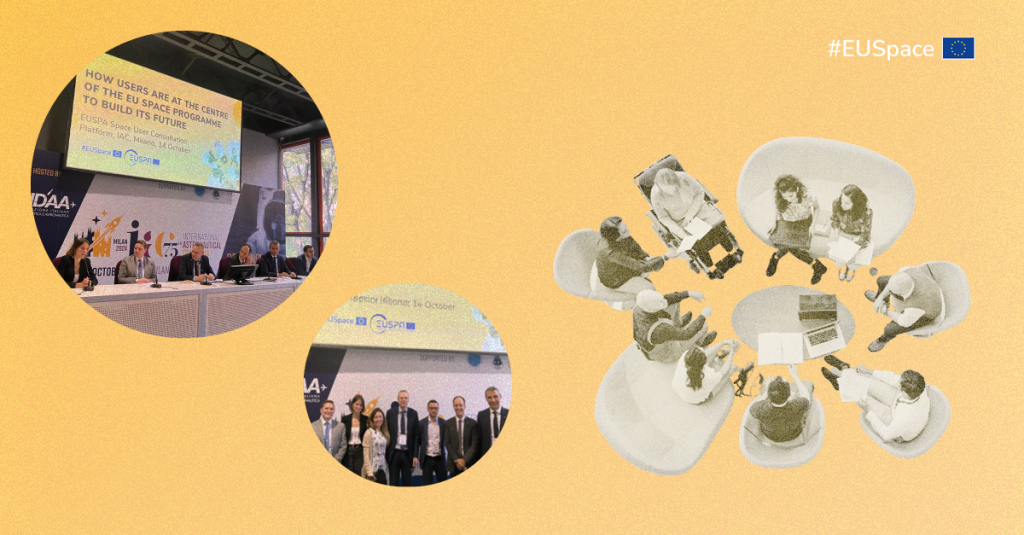Space-based solutions to user needs: 6th edition of the User Consultation Platform

October 2024 marks the 6th edition of the UCP (User Consultation Platform), the platform to hear the voices of the users and improve the EU space services to support their business. On 14 October, following 12 parallel dedicated workshops (held online on 8 October), high-level representatives of the EU Space Programme and stakeholders reported on the key user needs and requirements on the Plenary that took place within the IAC (International Astronautical Congress) in Milano. The consultation tackled different market segments, covering emergency management & humanitarian aid, health, urban development, maritime & inland waterways, tourism & cultural heritage, fisheries & aquaculture, energy, raw materials, insurance & finance, aviation & unmanned aerial vehicles, infrastructure management and timing & synchronization.
Rodrigo da Costa, Executive Director of the EU Agency for the Space Programme, highlighted that “EUSPA is bringing the users at the centre of the EU Space programme and the User Consultation Platform is one of our main tools to achieve this goal”. In fact, he explained, “the EUSPA GNSS and EO market report foresees that GNSS and Earth Observation (EO) global revenues in the downstream market are set to increase from more than €260 billion in 2023 to nearly €590 billion by 2033. Achieving these market figures requires meeting user needs. For example, the use of Copernicus to support drone safety was proposed in the UCP 2020. Now, work is ongoing with EASA, users, and stakeholders to facilitate its adoption. “
Christoph Kautz, Director for Satellite Navigation and Earth Observation for the European Commission affirmed that “the User Consultation Platform is a unique and key initiative of the EU Space Programme to hear the voices of the users and improve the EU space services so that they can enable more competitiveness and new business in Europe”. This way, he told the stakeholders, “our objective today is to gather your needs for all Space components to ensure that the service we deliver continue to contribute to sustainable growth, security, and safety.”
Fiammetta Diani, EUSPA Head of Market Downstream and Innovation Department, moderated the roundtable with users for them to provide their key finding and needs. She announced that the consultation results will be published on the EUSPA website in an updated 'Users Needs and Requirements Report' and will guide future steps to foster space-related business opportunities.
A relevant example to this, in maritime and Inland waterways, comes with EUSPA collaboration with the International Organisation of Marine Aids to Navigation (IALA), to facilitate, among others, the use of GNSS and SBAS for navigation and the evolution of satellite and terrestrial communication means at sea (VDES), that requires robustness for both he positioning and the connection link. IALA representative, Thomas Southall, affirmed that “maritime users have many needs from the space sector particularly in PNT, resilience, connectivity and earth observation. This is demonstrated with collaborations on projects such as SBAS, VDES, route exchange and MASS. IALA looks forward to many collaborations in the future.”
Anthony Credoz, from Total Energies, brought up the benefits of Earth Observation for renewable energies and raw materials related industries. "Copernicus Program and Sentinel missions are helping us daily at democratizing Earth Observation inside TotalEnergies Company for low-carbon and sustainable energies prospection, production and distribution", he said.
The EU Space programme also addresses new applications areas not typically linked to Space. Alice Legrix de la Salle, from Axa Climate, brought as an example the view of the Insurance and finance markets, “Satellite imagery is fueling the expansion of parametric insurance, an innovative solution that activates payouts right after events like droughts, floods, or wildfires, bypassing the delays of traditional loss adjustments. Moreover, Earth observation data enables cost-efficient ESG (Environmental, social and governance) analysis and data collection, particularly in tracking zero deforestation, water and biodiversity risks. This supports compliance with sustainable finance regulations and alignment with Task Force on Climate-related Financial. Disclosures (TCFD) and Taskforce on Nature-related Financial Disclosures (TNFD) frameworks.”
Patrizio Vanni, from ENAV, brought the message of the aviation and drones community discussed at the UCP “ENAV, the Italian air navigation service provider, one of the pioneers on EGNOS development and adoption, discussed the benefits and future challenges of GNSS and Copernicus for aviation and drones.” While Aviation is a mature user of GNSS, they are also looking at Earth Observation, including how it can support design of approach procedures, in particular feasibility analysis and conceptual designs.
Overall, the UCP involving and listening actual users underscores the EU Space Programme's user-centric approach, aiming to enhance competitiveness and drive new business opportunities worldwide.
The final reports of the 2024 UCP will be available in the coming months.